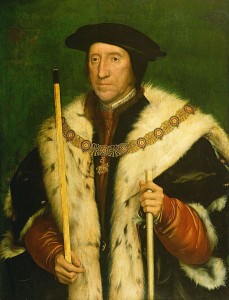
On this day in history, 12th December 1546, Henry Howard, Earl of Surrey was led through the streets of London from Ely Place, where he had been held since the 2nd December, to the Tower of London. There, he was joined by his father, Thomas Howard, 3rd Duke of Norfolk, who was taken to the Tower by barge along the Thames. In desperation, Norfolk wrote to the King the next day, proclaiming his innocence, confirming his loyalty to the King and offering the King his lands1:-
“Begs for grace. Some great enemy has informed the King untruly; for God knows, he never thought one untrue thought against the King or his succession, and can no more guess the charge against him than the child born this night. Desires that his accusers and he may appear before the King, or else the Council. Knows not that lie has offended any man, or that any are offended with him, “unless it were such as are angry with me for being quick against such as have been accused for Sacramentaries.” As for religion I have told your Majesty and many others that knowing your virtue and knowledge I shall stick to whatsoever laws you make; and for this cause divers have borne me ill will, “as doth appear by casting libels abroad against me.” Begs that he may recover the King’s favour, the King taking all his lands and goods; and that he may know what is laid to his charge and have some word of comfort from his Majesty.”2
Unfortunately for Howard, the King ignored him.
On the 12th January 1547, in the hope of saving himself, Norfolk made the following confession:
“I, Thomas duke of Norfolke do confess and knowledge myself to have offended the King in opening his secret counsels at divers times to sundry persons to the peril of his Highness and disappointing of his affairs. Likewise I have concealed high treason in keeping secret the false acts of my son, Henry earl of Surrey, in using the arms of St. Edward the Confessor, which pertain only to kings of this realm, whereto the said earl could make no claim. Also I have without authority borne in the first and principal quarter of my arms, ever since the death of my father, the arms of England with a difference of three labels of silver, which are the proper arms of my Lord the Prince. I confess my crime no less than high treason and, although I do not deserve it, humbly beg his Highness to have pity upon me, and I shall daily pray to God for the preservation of his noble succession. Written 12 Jan. in the year of our Lord God 1547”3
On the 27th January 1547, he was found guilty of treason by attainder and sentenced to death. His son, Surrey, had been found guilty of treason earlier that month, on the 13th January, when he was tried in front of a common inquest at Guildhall4. Despite pleading ‘not guilty’ and defending himself vigorously, he was found guilty, Historian Susan Brigden writes that “the records of the trial are now lost, but from evidence recorded by Lord Herbert of Cherbury it is clear that charges were brought and evidence given which concerned overt conspiracy as well as the usurpation of the royal arms”5. Surrey was sentenced to death.
Surrey was executed on the 19th January 1547 at Tower Hill, but his father was lucky because King Henry VIII died before he was due to be executed. He was kept in the Tower during Edward VI’s reign but released in 1553 when Mary I pardoned him.
Notes and Sources
- ‘Howard, Thomas, third duke of Norfolk (1473–1554)’, Michael A. R. Graves, Oxford Dictionary of National Biography, Oxford University Press, 2004
- LP xxi. Part 2. 540
- LP xxi. Part 2. 696
- ‘Howard, Henry, earl of Surrey (1516/17–1547)’, Susan Brigden, Oxford Dictionary of National Biography, Oxford University Press, 2004
- Ibid.